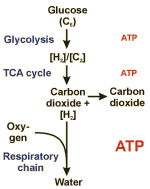 Metabolism
Metabolism
Network of enzymatic reactions, allowing the use of external energy and material.
The figure schematically shows the biochemical pathways within our body cells for the complete oxidation of glucose to carbon dioxide and water. This process corresponds to the burning of glucose, but conserves part of the energy stored in glucose in the form of ATP. The energy of ATP can be used to build up the compounds of our bodies or to fuel energy consuming processes.
Compounds used for the formation of ATP are lipids, carbohydrates and proteins. These nutrients are ultimately linked to plant photosynthesis, producing glucose from carbon dioxide using the energy of sun light. (Which corresponds to the reversal of the metabolic pathway presented above.) In addition, we need a number of compounds, which we canīt produce by ourselves: essential amino and fatty acids, various vitamins, mineral nutrients (sodium, potassium, calcium, magnesium...) and large amounts of water.
Due to their metabolism, organisms are dynamic chemical systems. All structures are continously degraded and rebuilt. This typical feature of living organisms results in their particular ability for adaptation and regeneration.